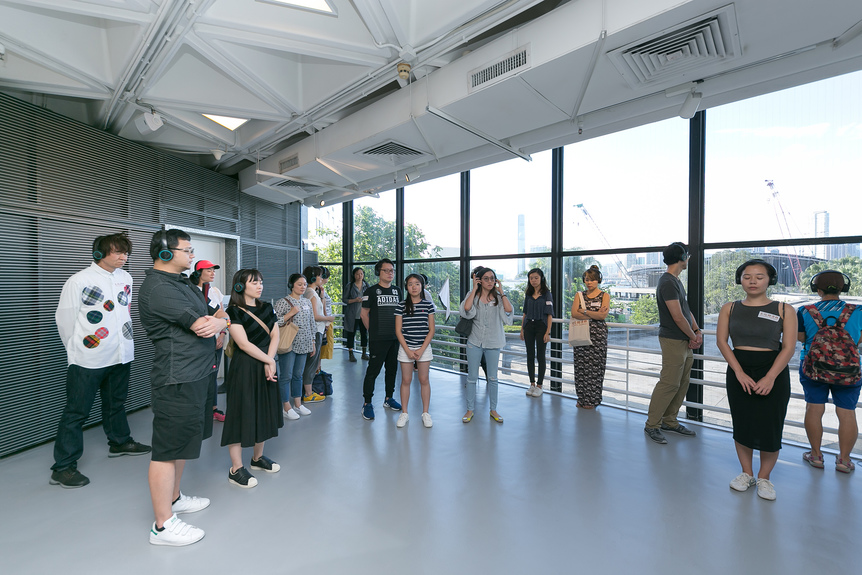
R
E
V N
E
X
T
Photo documentation of ENOCH CHENG’s Bon Voyage, 2018, performance, at the Hong Kong Arts Centre, 2018. All images by Sandy Au; courtesy Hong Kong Arts Centre.
In the brightly lit studio space, jazzy music played from a MacBook Pro. We were barefooted and not quite sure of what to expect from a “thematic walk,” as the event had been billed. The music, the sub-arctic conditions caused by an A/C malfunction, the no-shoes policy . . . I was beginning to fear that this would be no different from a high-school drama class, messy and awkward and ultimately fruitless, when the three performers sat down and started to chat with each member of the audience. As the room came alive with rapt conversation, the gesture struck me in its thoughtfulness. How it strayed from the usual artist-led mode of performance set the tone for the rest of the evening.
In “Bon Voyage,” Enoch Cheng and dancers Jennifer Mok and KT Yau brought the audience along on a journey—physically, through the crevices of the Hong Kong Arts Centre, and metaphysically, into the self. Each segment in the performance loosely corresponded with the four skills required of a Chinese opera performer: chang, zuo, nian, da (singing, acting, recitation, and acrobatics). This may seem ambitious for a one-and-a-half-hour show, but the three performers handled the wide range of skills and topics with ease.
Following the ice-breaking introduction—during which the artists also handed out blank cards sprayed with musty perfume, like those you get at the airport duty-free shop—Cheng walked to the center of the studio and guided us through what began as a stretching routine (da) and later became a kind of meditation workshop. As the performers stood still and the audience carried out the series of movements, momentarily, the audience took on the role of the performer, and the performers became the spectators.
Waving black-and-white tour-guide flags, the three performers then led us up to the second-floor lift lobby, and gave us headphones and handheld audio devices (chang). The recording introduced us to more grounding techniques: roll your eyeballs, walk and notice which foot you first put forward, use your back to push against the wall. While testing to see how long we could hold a jetliner position (apparently a form of physical torture), the narrator related the tale of the last quagga, a South African species of zebra that became extinct in the late 19th century.
We continued through the meandering corridors, past lobbies and practice rooms, dimly lit in the afterhours. On the staircase, we learned about Hong Kong’s SARS epidemic, a time when most of us would not even hold handrails for fear of catching germs; how from the windows of one quarantined hotel, guests would have been seeing the same views as we now were; and why fire poles were invented: to prevent horses in the fire service from climbing up the stairs in search of firemen’s lunches, back in the day.
In a conference room, we heard the story of a pregnant woman (referred to as “you”) who was shown a sonogram of her baby. Unaware that tails in fetuses are a remnant from our primate ancestors, she worries that the life growing in her is in fact that of a fish or a frog. A TV screen played a clip of an axolotl-like creature in the sea, then an infant swimming at a pool with incredible ease.
Finally, in a dance studio on the top floor, we sat in a circle, and traded thoughts and anecdotes about the notion of “journey.” Cheng concluded the discussion by reciting more factoids (nian), regarding the unknown origin of zebra stripes; the slower reflexes of fish; how their gills shifted upwards, morphing into noses when they reached land. He spoke of sentiments like “bon voyage” or, in Chinese, yi lu shun fung, “(have a) safe and pleasant journey,” expressed before a friend’s departure; and how, after this show, our paths may cross again, or not.
Photo documentation of ENOCH CHENG’s Bon Voyage, 2018, performance, at the Hong Kong Arts Centre, 2018.
All the while, Cheng mimed the flapping of a fish’s gills (zuo), the movements becoming more exaggerated until the grand finale: an experimental Chinese opera dance. In the absence of any traditional staging and costumes, he marched with two prop horsewhips; then, shouting out the only piece of dialogue in the sequence, “Bon voyage,” he ceded the stage to the two other performers. Mok and Yau proceeded to zou yuan tai, which is when performers walk quickly in a circle to enact a long journey, gaining momentum before halting to a stop with a roar.
“Bon Voyage” was a journey that started off by engaging with all five senses, grounding the audience in the here and now, and ended by connecting them with time and space. Through narratives woven into the performance, which were whimsical and at times poignant, the show contextualizes our existence in the grand scheme of Earth’s history, making it a unique and transcendental experience. All in all, it truly was a bon voyage.
Phoebe Tam is an editorial intern of ArtAsiaPacific.
Enoch Cheng’s “Bon Voyage” took place at the Hong Kong Arts Centre on July 26–29, 2018.
To read more of ArtAsiaPacific’s articles, visit our Digital Library.







